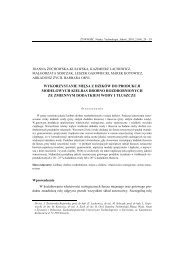fizykochemiczne i sensoryczne cechy sera twarogowego ...
fizykochemiczne i sensoryczne cechy sera twarogowego ...
fizykochemiczne i sensoryczne cechy sera twarogowego ...
Create successful ePaper yourself
Turn your PDF publications into a flip-book with our unique Google optimized e-Paper software.
FIZYKOCHEMICZNE I SENSORYCZNE CECHY SERA TWAROGOWEGO KWASOWEGO… 61<br />
PHYSICOCHEMICAL AND SENSORY FEATURES OF ACID CURD CHEESE (TVAROG)<br />
PRODUCED FROM GOAT’S MILK AND MIXTURE OF COW’S AND GOAT’S MILK<br />
S u m m a r y<br />
Physicochemical and sensory features were analyzed of the acid curd cheese (tvarog) produced from<br />
goat’s milk and a mixture of goat’s and cow’s milk (in two proportions) during a 3-week storage at a<br />
temperature of 5 ± 1 ºC. The samples for analysis were produced under the laboratory conditions and<br />
vacuum packed. Four (4) variants of tvarog cheese were produced: (i) tvarog made from cow’s milk; (ii)<br />
tvarog made from a mixture of goat’s and cow’s milk, in a 1:1 proportion; (iii) tvarog made from a mixture<br />
of goat’s and cow’s milk in a 2:1 proportion; and (iv) tvarog made from goat’s milk. The cheeses<br />
analyzed were sensory assessed and the following features were determined: content of water; content of<br />
fat; titratable acidity; pH; whey loss (leakage); and hardness. It was found that the tvarog cheeses differed<br />
from each other in their sensory features, content of water, content of fat, active acidity, and potential<br />
acidity. No significant differences were found in the amount of whey loss (leakage); its largest amount<br />
was reported in the tvarog made exclusively from goat’s milk.<br />
The samples analyzed had a normative chemical composition and along with the per cent content of<br />
the goat’s milk in the processed milk, the content of water increased simultaneously. The reported decrease<br />
in the titratable acidity was statistically significant, whereas the time of storing the cheeses did not<br />
impacted the pH level of the samples analyzed. The highest hardness had the tvarog cheese made from<br />
cow’s milk and the lowest: made from goat’s milk. The differences in the hardness of samples made from<br />
the mixture of the two milk kinds appeared to be statistically significant.<br />
Key words: goat’s milk, goat’s milk tvarog, physicochemical indicators, hardness
















